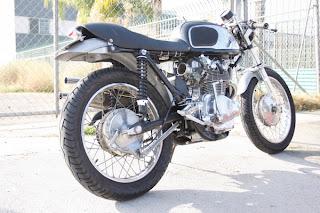Just for kicks I tried to start the engine when I first got the bike home, but even then I didn't have much hope for it starting. Of course it didn't. I pulled the plugs and found there was only a very weak spark. The plugs were also very well corroded into the head; I used lots of PB Blaster to get them loose so I didn't strip out the threads.

Once I had the plugs out I pulled off the points cover to check their condition. I sprayed a little contact cleaner onto them and ran a business card through the gap. No improvement. What I did notice, however, was the spark that blew across each point gap as it opened. This indicated that the condensors are bad. I didn't bother checking for voltage at the coils, which would be the next step, since I had several other things to attend to.
In the meantime, I spoke to the original owner of the bike. He's a really cool old guy who would still be riding if he hadn't taken a bad fall in the early 1980s. Turns out he has a small stash of new parts for the bike - coils, filters, points plate and a set of 29mm Mikuni smoothbore carbs. I will probably be buying them from him in the next week, since it will save me time and money versus restoring the stock carbs and buying new points.
Back to the engine: I removed the stock carburetors, since there is no point trying to get it to run without giving them a thorough cleaning. Sitting around for 25 years with fuel in them is the worst possible thing that can happen, since the dried out fuel will leave all kinds of nasty deposits inside each one.

I also removed the intake manifolds to give them a thorough inspection - behind each one is an o-ring that hardens and breaks over the years. Vacuum leaks here will cause poor running that will be hard to diagnose later. Removing the stock screws was a bit of a challenge - I used an impact driver on the outer two screws, but the remaining ones did not allow enough space to swing a hammer. I used the bit from the impact drive alone - a good whack of the ball-peen loosened them right up.
An inspection revealed that of course two of the orings were broken. The other two were so hard they were not acting as gaskets any longer. The manifolds themselves appeared in decent condition. No cracks, and the rubber was still flexible. The bond between the rubber and steel flange was loose around the outside edge of a couple of them, but the inside of the flange was still tightly bonded. They should work fine.

With the plugs out and carbs off, I attached a compression tester to each cylinder in turn. I cranked the engine over until the gauge did not increase. Ideal compression for an old 4-cylinder like this is in the 180psi range. The dry old cylinders only managed between 60 and 90 psi. Not good, but hopefully it was caused by stuck rings. First round: 90-80-60-60. I filled each cylinder with automatic transmission fluid to clear out the rings, and let it soak in.
I'll check the compression again after a few days; hopefully the ATF will loosen up the rings and compression will shoot back up. If it does not increase I'll still leave it for a while - the rings may loosen up after the engine runs for a little while. Only after I've put a few 100 miles on the bike will I worry about low compression.
So now that the carbs and engine had been inspected, I made an assessment of the engine condition for future work:
Engine Issues- Carbs crusty and dirty
- Manifold o-rings broken
- Manifold hardware corroded and damaged
- Low compression
- Minimal spark; arcing across points
- Case outer covers corroded and dull
- Starter cover rusty
- Cam covers rusty
- Missing air filter
- Oil old and unknown condition









